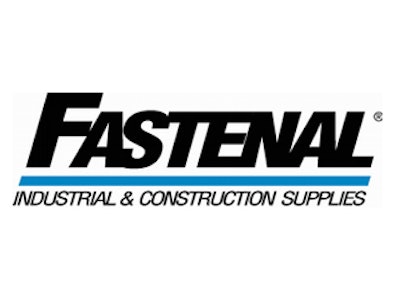
Winona, MN - Fastenal Company reported the results of the quarter ended June 30, 2014. Except for per share information, or as otherwise noted below, dollar amounts are stated in thousands.
Net sales (and the related daily sales), pre-tax earnings, net earnings, and net earnings per share were as follows for the periods ended June 30: |
| Six-month period | Three-month period | ||||
| 2014 | 2013 | Change | 2014 | 2013 | Change |
Net sales | $ 1,826,439 | 1,653,922 | 10.4% | $ 949,938 | 847,596 | 12.1% |
Business days | 127 | 127 |
| 64 | 64 |
|
Daily sales | $ 14,381 | 13,023 | 10.4% | $ 14,843 | 13,244 | 12.1% |
Pre-tax earnings | $ 385,627 | 367,551 | 4.9% | $ 206,782 | 192,379 | 7.5% |
% of sales | 21.1% | 22.2% |
| 21.8% | 22.7% |
|
Net earnings | $ 242,445 | 230,057 | 5.4% | $ 130,514 | 121,009 | 7.9% |
Net earnings per share (basic) | $ 0.82 | 0.78 | 5.1% | $ 0.44 | 0.41 | 7.3% |
BUSINESS UPDATE
In July 2013, we disclosed our intention to increase our investment in people at the store level and in additional leadership personnel at the district and regional levels. We felt this expanded investment was necessary to add 'selling energy' to the organization. With expanded investment, comes expanded expectations - in July 2013 we grew average daily sales over the same month in the preceding year in the low single digits, in June 2014 we grew average daily sales over the same month in the preceding year by 12.7%.
We believe these investments in 'selling energy', when combined with the related investments in 'support energy' (people, distribution, and internal manufacturing capabilities), in new store locations, and in FAST Solutions® (industrial vending) devices gives us a great platform for growth. Set forth below is information related to average employee headcount during the quarters indicated, and actual employee headcount, store count and FAST Solutions® (industrial vending) device count as of the end of the periods indicated:
|
|
|
|
| Year Over |
Average full-time equivalent store employee count | 10,446 | 9,771 | 6.9% | 8,943 | 16.8% |
Average full-time equivalent employee count | 15,427 | 14,482 | 6.5% | 13,413 | 15.0% |
Employee count | 18,135 | 17,277 | 5.0% | 15,760 | 15.1% |
Number of stores | 2,684 | 2,687 | -0.1% | 2,677 | 0.3% |
FAST Solutions® (industrial vending) machines (device count) | 43,761 | 40,775 | 7.3% | 36,452 | 20.1% |
Our business discussion below is extensive, but we believe necessary to convey our opportunities and challenges. The opportunities provided by a large end market are self-evident; however the current challenges center on two things: gross profit and working capital. As it relates to gross profit, our discussion later in this document provides a detailed explanation of trends and causes of fluctuations. This discussion also provides some book-ends to our gross profit range (51% to 53%). There are always competing priorities within any organization; for us, two of those priorities are sales growth and gross profit. Today, the dial is closer to sales growth and this is reflected in a lower gross profit percentage. We continue to believe in our stated range, but acknowledge the bottom half, and possibly just below the range, is a likely outcome for the short-term. Part of this acknowledgement relates to sources of our growth, which is heavily related to large customer success given the unique advantage our store-based business can bring to a multi-location customer.
This brings us to the second challenge - working capital. Most of the challenge relates to sales mix. Large customers have the ability to leverage their scale into the payment terms they command. This slow change in the mix of payment terms within our business has slowly extended the average number of days we have invested in accounts receivable. We have had similar short-term accounts receivable challenges in the past, and we have found ways to counteract the issue. This includes improving our billing and collecting processes, improving the sales volume and the related inventory leverage, and improving our sourcing. We believe we have the ability to address this issue in a similar fashion in the future.
We closed eight stores during the second quarter and identified additional stores we intend to close in the second half of 2014. This is described in greater detail later in this document under the caption 'GROWTH DRIVERS OF OUR BUSINESS'.
BUSINESS DISCUSSION
Similar to previous quarters, we have included comments regarding several aspects of our business:
- Monthly sales changes, sequential trends, and end market performance - a recap of our recent sales trends and some insight into the activities with different end markets.
- Growth drivers of our business - a recap of how we grow our business.
- Profit drivers of our business - a recap of how we increase our profits.
- Statement of earnings information - a recap of the components of our income statement.
- Operational working capital, balance sheet, and cash flow - a recap of the operational working capital utilized in our business, and the related cash flow.
While reading these items, it is helpful to appreciate several aspects of our marketplace: (1) it's big, the North American marketplace for industrial supplies is estimated to be in excess of $160 billion per year (and we have expanded beyond North America), (2) no company has a significant portion of this market, (3) many of the products we sell are individually inexpensive, (4) when our customer needs something quickly or unexpectedly our local store is a quick source, (5) the cost and time to manage and procure these products is meaningful, (6) the cost to move these products, many of which are bulky, can be significant, (7) many customers would prefer to reduce their number of suppliers to simplify their business, and (8) many customers would prefer to utilize various technologies to improve availability and reduce waste.
Our motto is Growth through Customer Service®. This is important given the points noted above. We believe in efficient markets - to us, this means we can grow our market share if we provide the greatest value to our customers. We believe our ability to grow is amplified if we can service our customers at the closest economic point of contact. For us, this 'closest economic point of contact' is the local store; therefore, our focus centers on understanding our customers' day, their opportunities, and their obstacles.
The concept of growth is simple, find more customers every day and increase your activity with them. However, execution is hard work. First, we recruit service minded individuals to support our customers and their business. Second, we operate in a decentralized fashion to help identify the greatest value for our customers. Third, we build a great machine behind the store to operate efficiently and to help identify new business solutions. Fourth, we do these things every day. Finally, we strive to generate strong profits; these profits produce the cash flow necessary to fund the growth and to support the needs of our customers.
SALES GROWTH
Net sales and growth rates in net sales were as follows:
Note - Daily sales are defined as the total net sales for the period divided by the number of business days (in the United States) in the period.
| Six-month period | Three-month period | ||
| 2014 | 2013 | 2014 | 2013 |
Net sales | $ 1,826,439 | 1,653,922 | $ 949,938 | 847,596 |
Percentage change | 10.4% | 5.1% | 12.1% | 5.3% |
|
|
|
|
|
| Six-month period | Three-month period | ||
| 2014 | 2013 | 2014 | 2013 |
Daily sales growth rate | 10.4% | 5.9% | 12.1% | 5.3% |
Impact of currency fluctuations (primarily Canada) | -0.5% | -0.1% | -0.4% | -0.1% |
The increase in net sales in the periods noted for 2014 and 2013 came primarily from higher unit sales. Our growth in net sales was impacted by slight inflationary price changes in our non-fastener products and some price deflation in our fastener products, but the net impact was a drag on growth. Our growth in net sales was not meaningfully impacted by the introduction of new products or services, with one exception. Over the last several years, our FAST Solutions® (industrial vending) initiative has stimulated faster growth with a subset of our customers (discussed later in this document). The higher unit sales resulted primarily from increases in sales at older store locations (discussed below and again later in this document) and to a lesser degree the opening of new store locations in the last several years. The growth in net sales at the older store locations was due to the growth drivers of our business (discussed later in this document). The impact of change in currencies in foreign countries (primarily Canada) relative to the United States dollar is noted in the table above.
MONTHLY SALES CHANGES, SEQUENTIAL TRENDS, AND END MARKET PERFORMANCE
This section focuses on three distinct views of our business - monthly sales changes, sequential trends, and end market performance. The first discussion regarding monthly sales changes provides a good mechanical view of our business based on the age of our stores. The second discussion provides a framework for understanding the sequential trends (that is, comparing a month to the immediately preceding month, and also looking at the cumulative change from an earlier benchmark month) in our business. Finally, we believe the third discussion regarding end market performance provides insight into activities with our various types of customers.
Monthly Sales Changes:
All company sales - During the months noted below, all of our selling locations, when combined, had daily sales growth rates of (compared to the same month in the preceding year):
| Jan. | Feb. | Mar. | Apr. | May | June | July | Aug. | Sept. | Oct. | Nov. | Dec. |
2014 | 6.7% | 7.7% | 11.6% | 10.0% | 13.5% | 12.7% |
|
|
|
|
|
|
2013 | 6.7% | 8.2% | 5.1% | 4.8% | 5.3% | 6.0% | 2.9% | 7.2% | 5.7% | 7.7% | 8.2% | 6.7% |
2012 | 21.3% | 20.0% | 19.3% | 17.3% | 13.1% | 14.0% | 12.1% | 12.0% | 12.9% | 6.8% | 8.2% | 9.7% |
Stores opened greater than two years - Our stores opened greater than two years (store sites opened as follows: 2014 group - opened 2012 and earlier, 2013 group - opened 2011 and earlier, and 2012 group - opened 2010 and earlier) represent a consistent 'same-store' view of our business. During the months noted below, the stores opened greater than two years had daily sales growth rates of (compared to the same month in the preceding year):
| Jan. | Feb. | Mar. | Apr. | May | June | July | Aug. | Sept. | Oct. | Nov. | Dec. |
2014 | 5.5% | 6.5% | 10.2% | 8.4% | 12.1% | 11.4% |
|
|
|
|
|
|
2013 | 5.0% | 6.5% | 3.4% | 3.1% | 3.5% | 4.3% | 1.4% | 5.5% | 4.2% | 6.1% | 6.2% | 4.9% |
2012 | 18.8% | 17.1% | 16.8% | 14.5% | 10.1% | 11.1% | 9.1% | 8.6% | 9.8% | 3.8% | 5.1% | 6.6% |
Stores opened greater than five years - The impact of the economy, over time, is best reflected in the growth performance of our stores opened greater than five years (store sites opened as follows: 2014 group - opened 2009 and earlier, 2013 group - opened 2008 and earlier, and 2012 group - opened 2007 and earlier). This group, which represented about 90% of our total sales in the first six months of 2014, is more cyclical due to the increased market share they enjoy in their local markets. During the months noted below, the stores opened greater than five years had daily sales growth rates of (compared to the same month in the preceding year):
| Jan. | Feb. | Mar. | Apr. | May | June | July | Aug. | Sept. | Oct. | Nov. | Dec. |
2014 | 4.6% | 5.4% | 9.5% | 7.7% | 11.5% | 10.8% |
|
|
|
|
|
|
2013 | 3.2% | 5.6% | 2.3% | 2.0% | 2.7% | 3.4% | 0.6% | 4.7% | 3.2% | 5.3% | 6.1% | 4.8% |
2012 | 17.4% | 15.8% | 15.7% | 13.7% | 9.0% | 10.2% | 8.3% | 7.9% | 8.5% | 2.6% | 4.6% | 5.6% |
Summarizing comments - There are three distinct influences to our growth: (1) execution, (2) currency fluctuations, and (3) economic fluctuations. This discussion centers on (2) and (3).
The change in currencies in foreign countries (primarily Canada) relative to the United States dollar impacted our growth over the last several years. During the years 2012 and 2013, it lowered our growth by 0.1% and 0.2%, respectively. In the first six months of 2014 it lowered our growth by 0.5%.
During 2012, the growth in the first three and a half months generally continued the relative strength we saw in 2011. Then we began to experience several distinct economic slowdowns. The first occurred in the late April/May time frame, and then moderated until September 2012. The second occurred in the October/November time frame. This was exaggerated by the impact of Hurricane Sandy and an unusual business day comparison in October (23 days in 2012 versus 21 days in 2011 - the maintenance portion of our business is often linked to monthly spend patterns of our customers, which are not as business day dependent, this can dilute the daily growth picture given the change in business day divisor). The third occurred in the spring of 2013. This involved our fastener product line and our construction business (primarily non-residential construction). This third slowdown, similar to the first two listed, mirrored or slightly led some softening in the PMI Index. The PMI Index is a composite index of economic activity in the United States manufacturing sector. It is published by the Institute for Supply Management and is available at http://www.ism.ws/. The fastener piece was heavily impacted by our industrial production business. These customers utilize our fasteners in the manufacture/assembly of their finished products. The end markets with the most pronounced weakening included heavy machinery manufacturers with exposure to: mining, military, agriculture, and construction. The fourth and fifth occurred in July 2013 and December 2013. The daily sales growth in July 2013 and December 2013 were negatively impacted by the timing of the July 4th holiday (Thursday in 2013, Wednesday in 2012, Monday in 2011) and the Christmas/New Year holiday (Wednesday in 2013, Tuesday in 2012, and Sunday in 2011). This resulted in a 'lone' business day on Friday, July 5, 2013, in which many of our customers were closed, and three distinct one to two day work periods in the last two weeks of December 2013. The December impact was amplified due to poor weather conditions.
Our daily sales growth trends have improved since September 2013. This was largely related to changing comparisons to 2012 and to the improving sequential patterns noted in the next discussion. Our sales to customers engaged in light and medium duty manufacturing (largely related to consumer products) are improving; this makes sense given the trends in the PMI Index.
In the first quarter of 2014, our sales growth was hampered in January and February due to a weak economy and foreign exchange rate fluctuations (primarily related to the Canadian dollar); however, the biggest impact was a severe winter in North America and its negative impact on our customers and our trucking network. In March 2014, the weak economy and negative foreign exchange rate fluctuations continued; however, the weather normalized and our daily sales growth expanded to 11.6%. This double digit growth in March was helped by the Easter timing (April in 2014), but the real story is good people, good execution, and minimal negative weather impacts. In the second quarter of 2014, the negative impact of the Easter timing was felt, and then a 'less noisy' picture emerged in May and June. One optimistic observation; our sales to customers engaged in heavy machinery manufacturing (primarily serving the mining, military, agricultural, and construction end markets), which represents approximately one fifth of our business, had a very weak 2013, but stabilized late in 2013 and has improved in the first six months of 2014.
Sequential Trends:
We find it helpful to think about the monthly sequential changes in our business using the analogy of climbing a stairway - This stairway has several predictable landings where there is a pause in the sequential gain (i.e. April, July, and October to December), but generally speaking, climbs from January to October. The October landing then establishes the benchmark for the start of the next year.
History has identified these landings in our business cycle. They generally relate to months with impaired business days (certain holidays). The first landing centers on Easter, which alternates between March and April (Easter occurred in April 2014, March 2013, and April 2012), the second landing centers on July 4th, and the third landing centers on the approach of winter with its seasonal impact on primarily our construction business and with the Christmas/New Year holiday. The holidays we noted impact the trends because they either move from month-to-month or because they move around during the week (the July 4th and Christmas/New Year holiday impacts are examples).
The table below shows the pattern to the sequential change in our daily sales. The line labeled 'Benchmark' is an historical average of our sequential daily sales change for the period 1998 to 2013, excluding 2008 and 2009. We believe this time frame will serve to show the historical pattern and could serve as a benchmark for current performance. We excluded the 2008 to 2009 time frame because it contains an extreme economic event and we don't believe it is comparable. The '2014', '2013', and '2012' lines represent our actual sequential daily sales changes. The '14Delta', '13Delta', and '12Delta' lines indicate the difference between the 'Benchmark' and the actual results in the respective year.
|
|
|
|
|
|
|
|
|
|
| Cumulative | |
|
|
|
|
|
|
|
|
|
|
| Change from | |
|
|
|
|
|
|
|
|
|
|
| Jan. to | |
| Jan. 1 | Feb. | Mar. | Apr. | May | June | July | Aug. | Sept. | Oct. | June | Oct. |
Benchmark | 0.8% | 2.2% | 3.8% | 0.4% | 3.1% | 2.7% | -2.1% | 2.5% | 3.7% | -1.2% | 12.6% | 15.9% |
2014 | -1.4% | 3.0% | 7.1% | -2.6% | 4.2% | 2.5% |
|
|
|
| 14.8% |
|
14Delta | -2.2% | 0.8% | 3.3% | -3.0% | 1.1% | -0.2% |
|
|
|
| 2.2% |
|
2013 | -0.4% | 2.0% | 3.4% | -1.1% | 1.0% | 3.2% | -5.5% | 5.5% | 2.9% | -2.9% | 8.7% | 8.2% |
13Delta | -1.2% | -0.2% | -0.4% | -1.5% | -2.1% | 0.5% | -3.4% | 3.0% | -0.8% | -1.7% | -3.9% | -7.7% |
2012 | -0.3% | 0.5% | 6.4% | -0.8% | 0.5% | 2.5% | -2.7% | 1.3% | 4.3% | -4.8% | 9.3% | 7.1% |
12Delta | -1.1% | -1.7% | 2.6% | -1.2% | -2.6% | -0.2% | -0.6% | -1.2% | 0.6% | -3.6% | -3.3% | -8.8% |
(1) The January figures represent the percentage change from the previous October, whereas the remaining figures represent the percentage change from the previous month. | ||||||||||||
A graph of the sequential daily sales change pattern discussed above, starting with a base of '100' in the previous October and ending with the next October, would be as follows: http://media.globenewswire.com/cache/11647/file/27516.pdf
This report has been truncated. For the full transcript, please click here.






















